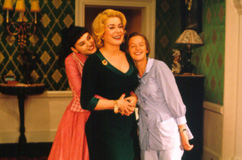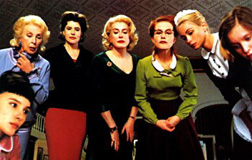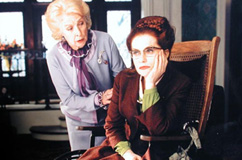8 Women (FranÁois Ozon) 2002
 Reportedly, French director FranÁois Ozon intended to follow
up his successful Under the Sand with a remake of George Cukorís 1939
catfight The Women, but was unable to secure the rights to do so. That
hardly stopped him, however. 8 Women, his new musical comedy / whodunit,
opens with a credits sequence thatís heavily influenced by Cukorís effort,
substituting that movieís parade of different animals alongside each cast
memberís name for a parade of flowers that reflect their personalities. The
similarities to The Women donít extend too deeply however. Like The
Women, 8 Women has an all-female cast (though there is one man seen
on screen, he has no lines), but the end result feels wildly different, mostly
because of the shift in genre. The Women seemed to approximate the point
of view of its female cast. 8 Women instead takes the stance of a great,
male admirer of women. The stunt casting of some of the top actresses in French
cinema is at once exhilarating (you feel worlds are colliding) and frustrating
(youíre almost always aware of the starís persona). You never get the sense
that weíre being given access to the female psyche while watching it, which
was notably a feeling that you couldnít escape during Under the Sand.
The observations of the movie mostly seem to stop with the purportedly
fascinating revelation that all women house secrets behind the exterior that
they project.
Reportedly, French director FranÁois Ozon intended to follow
up his successful Under the Sand with a remake of George Cukorís 1939
catfight The Women, but was unable to secure the rights to do so. That
hardly stopped him, however. 8 Women, his new musical comedy / whodunit,
opens with a credits sequence thatís heavily influenced by Cukorís effort,
substituting that movieís parade of different animals alongside each cast
memberís name for a parade of flowers that reflect their personalities. The
similarities to The Women donít extend too deeply however. Like The
Women, 8 Women has an all-female cast (though there is one man seen
on screen, he has no lines), but the end result feels wildly different, mostly
because of the shift in genre. The Women seemed to approximate the point
of view of its female cast. 8 Women instead takes the stance of a great,
male admirer of women. The stunt casting of some of the top actresses in French
cinema is at once exhilarating (you feel worlds are colliding) and frustrating
(youíre almost always aware of the starís persona). You never get the sense
that weíre being given access to the female psyche while watching it, which
was notably a feeling that you couldnít escape during Under the Sand.
The observations of the movie mostly seem to stop with the purportedly
fascinating revelation that all women house secrets behind the exterior that
they project.
 Of course, such a message makes sense in a murder mystery,
and when taken as an example of its genre 8 Women is easily as satisfying
as anything produced in the last ten years, but itís the technical delights of
the movie that gave me the most pleasure. The ornate, set-bound production
design owes a debt to the work of Douglas Sirk, and in many respects Ozon does a
better job than Todd Haynes (director of this seasonís other extended homage
to the director, Far From Heaven) in aping the rhythms and look of
Sirkís films. Colors remain lush throughout and the wonderful costumes and
hairstyles define the ladies that wear them. From the very start of the film,
weíre tipped off that secrets lurk behind the walls of the mansion when a
closet is revealed from its wallpaper camouflage. Compositionally, Ozon is
working at peak levels, and thereís a lot of pleasure just from watching the
inventive ways he arranges his actresses when he attempts to squeeze as many as
possible into the frame. Frankly, I felt there was enough going on artistically
before the film launched into its musical sequences that when they arrived, I
was usually let down. Itís not exactly that they are jarring, but they feel a
bit gimmicky and obligatory at times, especially when compared with the high
caliber of the rest of the film.
Of course, such a message makes sense in a murder mystery,
and when taken as an example of its genre 8 Women is easily as satisfying
as anything produced in the last ten years, but itís the technical delights of
the movie that gave me the most pleasure. The ornate, set-bound production
design owes a debt to the work of Douglas Sirk, and in many respects Ozon does a
better job than Todd Haynes (director of this seasonís other extended homage
to the director, Far From Heaven) in aping the rhythms and look of
Sirkís films. Colors remain lush throughout and the wonderful costumes and
hairstyles define the ladies that wear them. From the very start of the film,
weíre tipped off that secrets lurk behind the walls of the mansion when a
closet is revealed from its wallpaper camouflage. Compositionally, Ozon is
working at peak levels, and thereís a lot of pleasure just from watching the
inventive ways he arranges his actresses when he attempts to squeeze as many as
possible into the frame. Frankly, I felt there was enough going on artistically
before the film launched into its musical sequences that when they arrived, I
was usually let down. Itís not exactly that they are jarring, but they feel a
bit gimmicky and obligatory at times, especially when compared with the high
caliber of the rest of the film.
 When all is said and done, however, 8 Women is a
sheer delight. The series of revelations that define this filmís plot
initially feel like a laundry list of family dysfunction, but eventually make
the picture so contrived that its contrivances become half of the fun. The
performances are all excellent, with special mention going out to Isabelle
Huppert, who demonstrates genuine comic flair without ever sacrificing the
intensely smoldering emotion thatís defined most of her best work. Her
high-strung Augustine steals every scene sheís in, mostly because she usually
seems to be acting in a different, more exaggerated film than the rest of the
cast. Without the ensembleís confidence in her performance, it might have been
a wreck, but due to their deference it works brilliantly. Every seemingly
insignificant, color-coded fragment of the pictureís makeup coheres into a
satisfying whole (though the Sapphic sexuality that bubbles up with alarming
frequency might be a bit much).
When all is said and done, however, 8 Women is a
sheer delight. The series of revelations that define this filmís plot
initially feel like a laundry list of family dysfunction, but eventually make
the picture so contrived that its contrivances become half of the fun. The
performances are all excellent, with special mention going out to Isabelle
Huppert, who demonstrates genuine comic flair without ever sacrificing the
intensely smoldering emotion thatís defined most of her best work. Her
high-strung Augustine steals every scene sheís in, mostly because she usually
seems to be acting in a different, more exaggerated film than the rest of the
cast. Without the ensembleís confidence in her performance, it might have been
a wreck, but due to their deference it works brilliantly. Every seemingly
insignificant, color-coded fragment of the pictureís makeup coheres into a
satisfying whole (though the Sapphic sexuality that bubbles up with alarming
frequency might be a bit much).
* * * 1/2
09-22-02
Jeremy Heilman